Science of the Winter Olympics: Movement & Robotics
By Judy Elgin Jensen
Posted on 2014-02-21
 Did you see an Olympic performance (perhaps Davis & White’s gold-medal ice dance) that looked so perfect, so flawless, that it seemed almost robotic? If so, you’ll want to watch Olympic Movement & Robotic Design—another installment in the Science and Engineering of the 2014 Winter Olympic Games from NBC Learn and NSF. It’s amazing the parallels between the programming of robots and that of our own organic computer—the brain.
Did you see an Olympic performance (perhaps Davis & White’s gold-medal ice dance) that looked so perfect, so flawless, that it seemed almost robotic? If so, you’ll want to watch Olympic Movement & Robotic Design—another installment in the Science and Engineering of the 2014 Winter Olympic Games from NBC Learn and NSF. It’s amazing the parallels between the programming of robots and that of our own organic computer—the brain.
Then take a look at the companion NSTA-developed lesson plans, which are reviewed by several educators before making it to this post. One of the reviewers kept mentioning a variation of have kids sketch this idea, process, or structure—whatever was appropriate. Seems natural for primary students, but middle grades? A quick search on sketches and comprehension turned up these two articles on the value of sketches to student understanding.
If sketching seems a bit foreign, start with the lesson plans for this video, which prompt students to flowchart their programming instructions. This more structured drawing might pave the way for freehand sketches of both macro- and micro-scale ideas.
If you’re tuning in late to this series, look for them at www.NBCLearn.com and www.science360.gov. The downloadable lesson plans in editable Word format are linked below. Remember, if you made significant changes to a lesson, we’d love to see what you did differently, as well as why you made the changes. Leave a comment, and we’ll get in touch with you with submission information.
Video
Olympic Movement & Robotic Design discusses precision and the practice needed to achieve it in Olympic athletics and how a type of robotic flyer called a quadrocopter can mimic Olympic athletic tasks.
Lesson Plans
Olympic Movement & Robotic Design Integration Guide spells out the STEM in the video and gives you mini-activities and ideas for research, teamwork, projects, and interdisciplinary connections.
Olympic Movement & Robotic Design Inquiry Guide models a science inquiry AND an engineering design inquiry that introduces the relationship of programming and learning and the use of flowcharts.
January 2014 image of Meryl Davis and Charlie White at practice, courtesy of Adam Glanzman.
You can use the following form to e-mail us edited versions of the lesson plans: [contact-form 2 “ChemNow]
 Did you see an Olympic performance (perhaps Davis & White’s gold-medal ice dance) that looked so perfect, so flawless, that it seemed almost robotic? If so, you’ll want to watch Olympic Movement & Robotic Design—another installment in the Science and Engineering of the 2014 Winter Olympic Games from NBC Learn and NSF. It’s amazing the parallels between the programming of robots and that of our own organic computer—the brain.
Did you see an Olympic performance (perhaps Davis & White’s gold-medal ice dance) that looked so perfect, so flawless, that it seemed almost robotic? If so, you’ll want to watch Olympic Movement & Robotic Design—another installment in the Science and Engineering of the 2014 Winter Olympic Games from NBC Learn and NSF. It’s amazing the parallels between the programming of robots and that of our own organic computer—the brain.
NSTA conference tips
By Mary Bigelow
Posted on 2014-02-18
 Are you attending the NSTA conference in Boston this spring? At this point, you should be registering, making arrangements for lodging and transportation, and thinking about your lesson plans for the substitute (if you haven’t done so already).
Are you attending the NSTA conference in Boston this spring? At this point, you should be registering, making arrangements for lodging and transportation, and thinking about your lesson plans for the substitute (if you haven’t done so already).
 If this is the first time you’ve attended the national conference, it can be overwhelming at first. Here are some suggestions to consider before you go, updated from last year:
If this is the first time you’ve attended the national conference, it can be overwhelming at first. Here are some suggestions to consider before you go, updated from last year:
- Consider attending the first–timers session on the first day. This year, Karen Ostlund is hosting the session Is This Your First NSTA Conference? on Thursday, April 11, 8:00–9:00 AM in the Westin Boston Waterfront, Harbor Ballroom I/II. It’s worth the time.
- Add the NSTA Conference page to your bookmarks or favorites. Be sure to check out the Conference Newcomer’s page.
- Decide what you’d like to focus on at the conference: More on the Next Generation Science Standards? What content, practices, or crosscutting concepts do you want to know more about? What topics do your students struggle with? Are you looking for new digital resources, textbooks, or equipment? Get suggestions from your colleagues, too. Ask your students what you should learn more about (related to science, of course!).
- Then go to the conference website and use the Session Browser/Scheduler to look at the session descriptions. You can print out a personal schedule or add the session information to your smartphone calendar (mine is getting full already). Pick a few sessions for each timeslot, in case the rooms are full. There are several conference venues (the conference center and several hotels), so allow travel time between sessions.
- Download the NSTA conference app to your smartphone or tablet. Search sessions to build a schedule that integrates with your calendar; access maps of the convention center, hotels, and exhibit hall, share the play–by–play with social media, complete session evaluations, and more.
- Preview the Conference Transcript section on the conference site to access online session evaluations and tools to track your professional development. This is a great way to show your administrators which sessions you attended—my principal was always impressed that I was at sessions all day into the late afternoon and on Saturday and Sunday!Some hints on what to take:
- An empty bag—preferably one with wheels—if you know you can’t resist picking up any brochures, handouts, and session materials you encounter (resistance can be futile), although many presenters are now posting their handouts online.
- Address labels are handy for sign–up sheets and marking your program and other materials.
- If you don’t have any business cards, get some or make your own. Be sure to include your e–mail address and what and where you teach. These are great to hand out when you’re networking with other teachers, presenters, and exhibitors.
- A camera is handy to take pictures of equipment, displays, speakers, and new friends.
- Have an envelope or other system for keeping receipts and other documents. Expenses not reimbursed by your school might be tax–deductible (check with your accountant).
- Chargers and adapters for your electronic devices.
- Above all, take comfortable walking shoes and be prepared for the Boston weather!
- Pick up your badge holder, your copy of the program (there’s one for each day, unless you opt for the electronic version) and other conference materials ahead of time, if possible. Take some time to finalize your daily schedules. I like to put a small reminder in my badge holder with the session names, times, and locations. You can also stash a few of your business cards in your badge holder, making it easier to hand them out to new contacts. Keep your smartphone handy if you’ve created a calendar on it.
- Evaluate your sessions online. They’ll be automatically added to your transcript.
- Unless you’ve signed up (and paid for) a special event, the sessions are first–come, first–served. So get to the sessions early. Sometimes the smaller rooms fill up quickly. Have a back–up session in mind in case the room is full.
- Divide and conquer if you’re attending with friends or colleagues. You can only be at one place at a time, so coordinate with other teachers on what to attend and how to share notes and materials from sessions.
- Consider taking some snacks and a water bottle (the concessions are often crowded at lunch time). There is no formal lunch break at the conference. Take your lunch to a session if it’s one you don’t want to miss! The presenter won’t mind.
- It’s tempting to collect every brochure, poster, and promotional giveaway in the exhibit area. It’s like a science wonderland! But whatever you collect, you’ll have to get home somehow. I know teachers who take an empty bag (see above under things to take) they can check on the way home (or you can ship things home via a delivery service).
- Stop by the booths at registration staffed by local teachers who can fill you in on the many science education and cultural opportunities in Boston. If you’re new to Boston, explore some of the important historical sites.
- Keep a log or journal of the sessions you attended, people you met, and new ideas. Update your homepage, Facebook, tweets, or class Wiki/blog with a summary of what you are learning at the conference. I’ve even seen teachers Skyping back to their students!
- Update your conference transcript.
- Put your cell phone on mute during sessions.
- Introduce yourself to teachers at the sessions or events. You’ll meet lots of interesting people and make many new personal connections. Although it’s important to keep up with your colleagues and classes back home via texts/tweets/email, take the opportunity to actually talk to the teachers in line with you or sitting next to you at a session. The value of a face–to–face conference is meeting and interacting with real people, and teachers are the most interesting people of all.
- Attend a session or two on a topic you know nothing about. It’s a good way to learn something new.
Back Home:
- Share your experiences with your students. Use some of the promotional items you collected as prizes or gifts.
- Organize and file your notes and handouts. Share the materials and what you learned with your colleagues.
- Send a note of appreciation to the administrator who approved your attendance at the conference. Write a brief article for the school or district newsletter, if appropriate.
- Access your transcript online to add to your professional portfolio.
- Get ready for next year!
Add a comment with any other suggestions. See you in Boston!
 Are you attending the NSTA conference in Boston this spring?
Are you attending the NSTA conference in Boston this spring?
Science of the Winter Olympics: Physics of Figure Skating
By Judy Elgin Jensen
Posted on 2014-02-17
 Many would call the figure skating events the most elegant of all of the winter Olympic sports. The spins. The tosses. The leaps. How on earth do they stay in balance? Find out by watching the latest installment of the Science and Engineering of the 2014 Winter Olympic Games, the video series created by NBC Learn and NSF that delivers a behind-the-scenes look at what the medal-seeking athletes really do.
Many would call the figure skating events the most elegant of all of the winter Olympic sports. The spins. The tosses. The leaps. How on earth do they stay in balance? Find out by watching the latest installment of the Science and Engineering of the 2014 Winter Olympic Games, the video series created by NBC Learn and NSF that delivers a behind-the-scenes look at what the medal-seeking athletes really do.
The Engineering Design component of the Inquiry Guide in the NSTA-developed lesson plans explores the idea of how pairs figure skaters move back-and-forth between two independent systems and one cohesive system. The definition of a system can figure prominently in how engineers develop models. What, exactly, constitutes the system under study? Are aspects of the system really functioning independently, and are simply in the same space at the same time? If so, can the behavior of the independent systems be predicted so that one can predict how the larger, single system works?
This is just one question that illustrates where the processes of science and engineering overlap. Compare and contrast the Science Inquiry and the Engineering Design Inquiry in each of the Inquiry Guides for these videos to get a better understanding of how to talk about and incorporate engineering design processes in your investigations.
Figure skating events continue through February 20. Watch for Gracie Gold to nail her leaps. Then show your students how she uses science to do it. The video series, available cost-free, is on www.NBCLearn.com and www.science360.gov. Link to the downloadable lesson plans below. Let us know what you think—inquiring minds want to know!
Video
Physics of Figure Skating discusses the important concepts of center of mass and projectile motion in figure skating.
Lesson Plans
Physics of Figure Skating Integration Guide spells out the STEM in the video and gives you mini-activities and ideas for research, teamwork, projects, and interdisciplinary connections.
Physics of Figure Skating Inquiry Guide models a science inquiry into predicting and finding the location of the center of mass of a system AND an engineering design inquiry focusing on identifying parts of a system and developing a model for defining a system.
Photo of figure skating in action in Sochi courtesy of Atos International.
You can use the following form to e-mail us edited versions of the lesson plans: [contact-form 2 “ChemNow]
 Many would call the figure skating events the most elegant of all of the winter Olympic sports. The spins. The tosses. The leaps. How on earth do they stay in balance? Find out by watching the latest installment of the Science and Engineering of the 2014 Winter Olympic Games, the video series created by NBC Learn and NSF that delivers a behind-the-scenes look at what the medal-seeking athletes really do.
Many would call the figure skating events the most elegant of all of the winter Olympic sports. The spins. The tosses. The leaps. How on earth do they stay in balance? Find out by watching the latest installment of the Science and Engineering of the 2014 Winter Olympic Games, the video series created by NBC Learn and NSF that delivers a behind-the-scenes look at what the medal-seeking athletes really do.
Planning and carrying out investigations
By Mary Bigelow
Posted on 2014-02-14
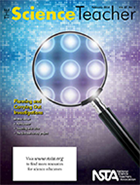 According to the editor, “Although the practice of planning and carrying out investigations has always been a part of good science instruction, the student focus often has been more on carrying out than on planning, with teacher-structured investigations far outnumbering student opportunities to develop their own research questions. Giving students opportunities to design and plan investigations allows them to truly experience the excitement of science and better understand the nature of scientific inquiry.”
According to the editor, “Although the practice of planning and carrying out investigations has always been a part of good science instruction, the student focus often has been more on carrying out than on planning, with teacher-structured investigations far outnumbering student opportunities to develop their own research questions. Giving students opportunities to design and plan investigations allows them to truly experience the excitement of science and better understand the nature of scientific inquiry.”
But this doesn’t mean that the teacher says “Do an investigation” and wait for the students to come up with something. The featured articles in this issue show how teachers can provide background information and preliminary experiences so that students can “practice” real science.
For example, Pond Power refocuses a traditional activity to incorporate research on how algae could be a renewable alternative to fossil fuels. After an awareness activity in which students examine the algae species found in pondwater, they go on to investigate how to grow algae in the lab and design and then build photobioreactors. The article has suggestions for assessment and interdisciplinary connections. The extensive list of resources has rubrics and additional suggestions. [SciLinks: Algae]
Elementary and middle school students do activities with light bulbs and circuits. Teaching Electricity and Engineering With LEDs shows how to extend this with investigations using LEDs. I like how the authors describe “tinkering time”—time for students to practice critical thinking and brainstorming and how students can use their knowledge to design electronic devices. [SciLinks: Electric Circuits, Electric Current]
For a field biology class, The Bird Box Survey Project would be an authentic citizen science project. The data collected by the students could be used in a variety of investigations on bird behavior. If your school is not near a nature center or outdoor facility, you can still conduct ongoing investigations—see the SciStarter site for ideas.
The author of Can You Picture That? shares a 5e lesson on how to design and conduct an investigation to test the validity of popular claims. Given a statement such as “Touching a toad will give you warts” or “Listening to classical music increases SAT scores,” students working in teams design a strategy to test the statement. The twist is that they are not allowed to use words to explain their design—only pictures (think of the game Pictionary). Their focus is on the process, not vocabulary such as constant or independent variable (these can be introduced later). The article includes examples of student work and suggestions for implementation. I could see students really enjoying this!
Two other articles describe projects that could be done as student research. Get Grounded in Groundwater has resources for students to investigate their own local water sources. Although The Missing Piece: Classroom-Based Exercise is addressed to teachers, students could design a study of the effectiveness of exercise in class: what kind, how often, how much? Or it could be an interesting action research project for teachers. [SciLinks: Groundwater, Aerobic and Anaerobic Exercise]
 According to the editor, “Although the practice of planning and carrying out investigations has always been a part of good science instruction, the student focus often has been more on carrying out than on planning, with teacher-structured investigations far outnumbering student opportunities to develop their own research questions.
According to the editor, “Although the practice of planning and carrying out investigations has always been a part of good science instruction, the student focus often has been more on carrying out than on planning, with teacher-structured investigations far outnumbering student opportunities to develop their own research questions.
Science of the Winter Olympics: Faster & Safer Bobsleds
By Judy Elgin Jensen
Posted on 2014-02-13
 Controlled violence. That’s what Steve Langton of the U.S. Bobsled Team calls his sport, in which he’s huddled in a bullet-shaped, finned shell made of carbon fiber and Kevlar hurtling down a curving track at speeds over 70 miles per hour. The team’s bobsled designer, Michael Scully of BMW DesignWorks USA, agrees based on a quote from a Bloomberg.com interview: “Just the brutality and the violence of it was something that really left an impact on me.”
Controlled violence. That’s what Steve Langton of the U.S. Bobsled Team calls his sport, in which he’s huddled in a bullet-shaped, finned shell made of carbon fiber and Kevlar hurtling down a curving track at speeds over 70 miles per hour. The team’s bobsled designer, Michael Scully of BMW DesignWorks USA, agrees based on a quote from a Bloomberg.com interview: “Just the brutality and the violence of it was something that really left an impact on me.”
So what’s a bobsled designer to do? In the same interview, Scully said, “As a designer, it’s your responsibility to look at those experiences and try to leverage those into design directions.” Turn your students into bobsled designers by first showing them Building Faster & Safer Bobsleds, from the Science & Engineering of the 2014 Winter Olympic Games video series created by NBC Learn and NSF. Then, use the Engineering Design Inquiry from the NSTA-developed lesson plans to create your own bobsled competition.
This is one of those inquiry investigations where allowing students to “mess around” with the materials you have on hand will fuel their creativity. Of course, if someone asks, your students are “observing the materials’ properties” or something that doesn’t sound quite so chaotic!
Tune in to the Games on NBC TV on February 18–23 to see the bobsled (and the USA Team) in action. Then find the video series, available cost-free, on www.NBCLearn.com and www.science360.gov. Link to the downloadable lesson plans below. Leave a comment to let us know what you think!
Video
Building Faster & Safer Bobsleds discusses how the research and design of modern bobsleds changes the speed and safety of Olympic bobsledding.
Lesson Plans
Faster & Safer Bobsleds Integration Guide spells out the STEM in the video and gives you mini-activities and ideas for research, teamwork, projects, and interdisciplinary connections.
Faster & Safer Bobsleds Inquiry Guide models a science inquiry into factors that impact a bobsled’s movement AND an engineering design inquiry focusing designing and testing a bobsled.
Photo of “The Night Train” team, which won an Olympic gold medal in bobsleigh for Team USA for the first time in 62 years, by U.S. Army photo by Tim Hipps, IMCOM Public Affairs.
You can use the following form to e-mail us edited versions of the lesson plans: [contact-form 2 “ChemNow]
 Controlled violence. That’s what Steve Langton of the U.S. Bobsled Team calls his sport, in which he’s huddled in a bullet-shaped, finned shell made of carbon fiber and Kevlar hurtling down a curving track at speeds over 70 miles per hour. The team’s bobsled designer, Michael Scully of BMW DesignWorks USA, agrees based on a quote from a Bloomberg.com interview: “Just the brutality and the violence of it was something that really left an impact on me.”
Controlled violence. That’s what Steve Langton of the U.S. Bobsled Team calls his sport, in which he’s huddled in a bullet-shaped, finned shell made of carbon fiber and Kevlar hurtling down a curving track at speeds over 70 miles per hour. The team’s bobsled designer, Michael Scully of BMW DesignWorks USA, agrees based on a quote from a Bloomberg.com interview: “Just the brutality and the violence of it was something that really left an impact on me.”
Social Science Teachers: Meet Us at #NSTA14
By Lauren Jonas, NSTA Assistant Executive Director
Posted on 2014-02-12
 How do you start an #organellewar? Create a virtual Professional Learning Community? Use Facebook with preservice teachers? Flip your classroom? Use YouTube in your science classroom? Five social-savvy science teachers will be gathering at the National Science Teachers Association’s National Conference on Science Education in Boston on Saturday, April 5, for a dynamic, interactive session to answer these questions and more.
How do you start an #organellewar? Create a virtual Professional Learning Community? Use Facebook with preservice teachers? Flip your classroom? Use YouTube in your science classroom? Five social-savvy science teachers will be gathering at the National Science Teachers Association’s National Conference on Science Education in Boston on Saturday, April 5, for a dynamic, interactive session to answer these questions and more.
Learn how science teachers use social media, both in the classroom and in their own time for professional development. Join us for this dynamic session that will focus on classroom-tested strategies, insight into how to use this powerful networking tool, and a Q&A session. Come ready to share–the presenters hope to learn as much from you as you learn from them!
Who
- Paul Andersen @paulandersen
- Jon Bergmann @jonbergmann
- Brad Graba @mr_graba
- Cheska Lorena @MissCheska
- Christine Royce @caroyce
- Moderator: Lauren Jonas @LaurenE_Jonas
What
Session: The Social Science Teacher
(Open to all attendees registered for the NSTA National Conference on Science Education)
When
Saturday, April 5 12:30–2:30 PM
Where
Boston Convention & Exhibition Center, 252A
Hashtags
general conference hashtag #NSTA14
session hashtag #NSTAlive
Questions?
Tweet @nsta or e-mail social@nsta.org
DiscoverE brings us Engineers Week
By Peggy Ashbrook
Posted on 2014-02-11
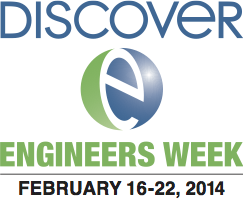 Next week is Engineers Week, February 16-22, “a time to:
Next week is Engineers Week, February 16-22, “a time to:
- Celebrate how engineers make a difference in our world
- Increase public dialogue about the need for engineers
- Bring engineering to life for kids, educators, and parents”
DiscoverE website has an excellent self-guided tutorial for volunteers and educators, with tips and advice on leading a hands-on engineering experience for children ages, and inspiring photographs of children involved in engineering activities. The advice includes:
- Do the activity yourself before you introduce it.
- Identify learning goals.
- Make modifications if necessary.
- Think of ways to extend the challenge.
- Emphasize the value of brainstorming and exploration, rather than right and wrong.
- Use open-ended questions to guide.
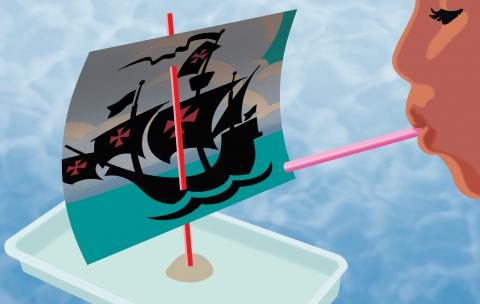 The website has a selection of activities in case you don’t yet have an engineering curriculum. Use the “More filters here” tab (a bump on the left side of the horizontal blue line) to search for engineering activities for elementary and early childhood, such as, “Curious George Sailboat,” and adapt any that are above the level of your children.
The website has a selection of activities in case you don’t yet have an engineering curriculum. Use the “More filters here” tab (a bump on the left side of the horizontal blue line) to search for engineering activities for elementary and early childhood, such as, “Curious George Sailboat,” and adapt any that are above the level of your children.
To borrow from author Laura Numeroff…If you give children an engineering problem to work on, they are going to brainstorm a solution. If you give them materials to try build their designed solution, they are going test it and then re-design their solution…Once you and your students get involved in engineering, you will probably want to use resources to expanding the curriculum. DiscoverE suggests:
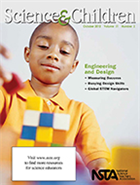 Science and Children, the National Science Teachers Association’s (NSTA) elementary journal, publishes “Engineering Encounters,” a column on engineering. Searching for “engineering” on the Science and Children page brought up 43 articles, including several “Teaching Through Tradebooks” columns. The October 2013 issue focuses on engineering. Use the NSTA resources to develop a curriculum that aligns with the Next Generation Science Standards which have a strong emphasis on engineering design.
Science and Children, the National Science Teachers Association’s (NSTA) elementary journal, publishes “Engineering Encounters,” a column on engineering. Searching for “engineering” on the Science and Children page brought up 43 articles, including several “Teaching Through Tradebooks” columns. The October 2013 issue focuses on engineering. Use the NSTA resources to develop a curriculum that aligns with the Next Generation Science Standards which have a strong emphasis on engineering design.
Share your favorite engineering resource by commenting below!
 I am looking forward to the 2014 USA Science & Engineering Festival in the nation’s capital on April 26-27, 2014. Held indoors at the Walter E. Washington Convention Center in Washington, D.C., it has booth after booth of activities for all ages. I wrote a post about the 2012 Festival.
I am looking forward to the 2014 USA Science & Engineering Festival in the nation’s capital on April 26-27, 2014. Held indoors at the Walter E. Washington Convention Center in Washington, D.C., it has booth after booth of activities for all ages. I wrote a post about the 2012 Festival.
While I wait for April to come, I’m going to check out the websites of all the Festival’s partners. There are many interesting organizations that promote the understanding of science and engineering concepts.
NSTA’s K-12 Science Education Journals: February Issues Online
By Lauren Jonas, NSTA Assistant Executive Director
Posted on 2014-02-08
It’s February, and many of us are focused on groundhogs, candy, and hoping never to hear the words polar vortex again! Spring is still a few months away, so this is a good time to bundle up and get a fresh look at what your science teaching peers are doing. The National Science Teachers Association (NSTA) produces grade-level journals, written by educators, for educators, and they are targeted to your teaching level. NSTA’s February K-12 journals are live online (with select articles being free for all, and full content being free to all NSTA members). Browse these issues for classroom-tested ideas, activities you can use tomorrow, and commentary from experts in the field.
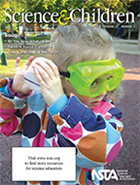 Science and Children
Science and Children
Since children experience sound even before birth, it is easy to assume that they know a great deal about it. However, ideas about sound are some of the most common misconceptions held by young children.
Featured articles (please note, only those marked “free” are available to nonmembers):
- Close Encounters of the Amphibious Kind
- Creative Sound Dramatics
- Do You Hear What I Hear?
- Free – Editor’s Note: Sound
- From Vibration to Vocalization
- Free – The Sound of Science
- Full Table of Contents
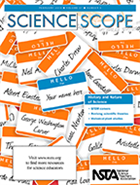 Science Scope
Science Scope
The Next Generation Science Standards affirm that students need to develop a thorough understanding of the entire enterprise of science, including the history and nature of science. Use the activities found in this issue to explore the complexities of this very human endeavor.
Featured articles (please note, only those marked “free” are available to nonmembers):
- Free – Career Simulations: Technology Tools That Support STEM Content and Motivation
- Connecting Students to STEM Careers
- Don’t Swat That Fly! Using House Flies in an Inquiry Activity
- Free – Editor’s Roundtable: Teaching the Nature of Science: Let the Story of Science Lead the Way
- Evolutionary Technology: Using Google Earth, Cyber Databases, and Geotagged Photos to Enhance Students’ Scientific Practices and Understanding of Darwin’s Theory of Evolution
- Historical Plant Studies: Tools for Enhancing Students’ Understanding of Photosynthesis
- Science Evolving
- The History and Nature of Science: Is the Past the Key to Our Future?
- Tracking Science: Following the STEM Trend
- Full Table of Contents
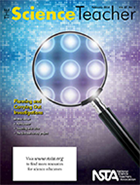 The Science Teacher
The Science Teacher
Although the practice of planning and carrying out investigations has always been a part of good science instruction, the student focus often has been more on carrying out than on planning, with teacher-structured investigations far outnumbering student opportunities to develop their own research questions. Giving students opportunities to design and plan investigations allows them to truly experience the excitement of science and better understand the nature of scientific inquiry. Just as basketball players need to practice shooting, passing, dribbling, and defense, so too do our science students need to practice real science by asking questions, designing investigations, analyzing data, and communicating results. Engaging in these practices helps students appreciate the wide range of approaches used in science and engineering to investigate and explain the world.
Featured articles (please note, only those marked “free” are available to nonmembers):
It’s February, and many of us are focused on groundhogs, candy, and hoping never to hear the words polar vortex again! Spring is still a few months away, so this is a good time to bundle up and get a fresh look at what your science teaching peers are doing. The National Science Teachers Association (NSTA) produces grade-level journals, written by educators, for educators, and they are targeted to your teaching level. NSTA’s February K-12 journals are live online (with select articles being free for all, and full content being free to all NSTA members).
History and nature of science
By Mary Bigelow
Posted on 2014-02-08
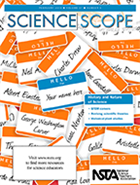 If you think that the “history and nature of science” means students reading biographies of scientists of the past, your thoughts may change after browsing this issue of Science Scope. These articles represent lessons that incorporate the past, present, and future of science.
If you think that the “history and nature of science” means students reading biographies of scientists of the past, your thoughts may change after browsing this issue of Science Scope. These articles represent lessons that incorporate the past, present, and future of science.
The History and Nature of Science: Is the Past the Key to Our Future? This question is addressed in a study that compares historical studies to those of today. The focus is on evidence as students examine the concepts of uniformitarianism, catastrophism, and climate change. [SciLinks: Causes of Climate Change]
Science Evolving describes a yearlong exploration of famous life scientists that results in a classroom timeline. The author includes a list of scientists, an example of how to guide students through primary sources, and a photo of the timeline. The activities matched up with the content being studied. [SciLinks: Scientist Biographies]
One misconception students have is that plants absorb food through the roots (I wish that fertilizer and garden ads would stop using the term “plant food”). The author of Historical Plant Studies: Tools for Enhancing Students’ Understanding of Photosynthesis developed a 5e lesson that helps students understand photosynthesis by considering historical studies in botany. The article includes descriptions of these studies and some student-created graphic organizers. [SciLinks: Photosynthesis]
Imagine Darwin’s voyage if present-day technology were available then. Evolutionary Technology: Using Google Earth, Cyber Databases, and Geotagged Photos to Enhance Students’ Scientific Practices and Understanding of Darwin’s Theory of Evolution describes an activity that incorporates Google Earth, cyber databases, and geotagged photos and guides students through defining a problem, locating information, organizing and presenting information, and drawing conclusions. Although we may think of students as digital natives, the authors note that they may have a basic understanding of applications but might not be aware of all of the capabilities. “Teachers may need to create a lesson focused solely on how to use the tool.” But then just watch them! [SciLinks: Charles Darwin, Galapagos Islands, Biological Evolution]
Who would think of using the lowly and annoying housefly to help students understand scientific principles? Don’t Swat That Fly! Using House Flies in an Inquiry Activity embeds the study of adaptations and characteristics of houseflies into a “mystery” to be solved. The article includes a copy of the activity worksheet/directions. [SciLinks: Insects]
Solving a present-day, authentic problem is the focus of Tracking Science: Following the STEM Trend*. After a review of related science concepts, students identified a problem, planned a solution and constructed and tested their trackers. [SciLinks: Seasons, Solar Cells]
The future of science is in our classrooms today, assuming that students choose STEM-related careers. The authors of Career Simulations: Technology Tools That Support STEM Content and Motivation describe several free science simulations that connect science curricula to real-life experiences, such as forensics, neuroscience, and medical research. The URLs of the projects are noted at the end of the article.
Trying to find an alternative to the do-a-report-on-a-career activity? Connecting Students to STEM Careers describes an ongoing STEM career awareness project that ties into curriculum topics. The project consists of 3-5 minute videos and fact sheets on 89 careers (so far). These emphasize technology and engineering, the inclusion of female and minority scientists, opportunities for creativity and problem-solving, and related careers that do not require 4-year or graduate degrees. Talk about going beyond the “mad scientist” stereotype! The authors note that “teachers who do not have a whole day to devote to STEM careers can add video clips to daily or weekly instruction.” I had a day or two in between units for students to catch up on tests and reports. These videos would fit in there.
If you do want to have a career day with guest speakers and other events, Tried and True: How to Organize a STEM Career Day has suggestions for planning, a timeline/checklist, and samples of invitations and schedules. Seeing this gives you an appreciation for what goes into an NSTA conference!
[SciLinks on Careers: Biology, Life Science, Science, Chemistry, Environmental Science, Physics, Engineer, Biomedical Engineer]
*Check out the Connections for this issue (February 2014). Even if the article does not quite fit with your lesson agenda, this resource has ideas for handouts, background information sheets, data sheets, rubrics, etc.
 If you think that the “history and nature of science” means students reading biographies of scientists of the past, your thoughts may change after browsing this issue of Science Scope. These articles represent lessons that incorporate the past, present, and future of science.
If you think that the “history and nature of science” means students reading biographies of scientists of the past, your thoughts may change after browsing this issue of Science Scope. These articles represent lessons that incorporate the past, present, and future of science.
Engineers Week Resources from the National Science Teachers Association
By Lauren Jonas, NSTA Assistant Executive Director
Posted on 2014-02-07
 Engineers Week is February 16–22, 2014. Engineering is in the spotlight right now—and science teachers need to know how to incorporate it into their STEM curriculum, what resources really work, and where to get online PD to stay current. Use this resource collection from the National Science Teachers Association (NSTA) to find everything you need.
Engineers Week is February 16–22, 2014. Engineering is in the spotlight right now—and science teachers need to know how to incorporate it into their STEM curriculum, what resources really work, and where to get online PD to stay current. Use this resource collection from the National Science Teachers Association (NSTA) to find everything you need.
Elementary Resources
Core Ideas of Engineering and Technology
This article from Science and Children addresses Chapter 8 of A Framework for K–12 Science Education, which presents core ideas in technology and engineering at the same level as core ideas in the traditional science fields. (free)
Problem Solvers
This book chapter from Even More Picture-Perfect Science Lessons, K-5: Using Children’s Books to Guide Inquiry presents a lesson that introduces Benjamin Franklin’s timeless inventions to inspire students to use the engineering design process to solve some of their own everyday problems. ($2.79 – NSTA Member Price; $3.49 – Nonmember Price)
Archived Web Seminar: Engineering Practices in the Next Generation Science Standards
Presented by Mariel Milano, P-SELL and STEM Coordinator for Orange County Public Schools, this archived web seminar focuses on the role of technology and engineering in the Next Generation Science Standards (NGSS). (free)
The Crooked Swing
This book chapter from Yet More Everyday Science Mysteries: Stories for Inquiry-Based Science Teaching presents a story that allows the reader to apply what is known about pendulums to a new problem and to use technical skills to solve a problem. ($2.79 – NSTA Member Price ; $3.49 – Nonmember Price)
Middle School Resources
Web Seminar: Engineering Design Challenge: Spacecraft Structures, February 26, 2014 (mark your calendar!)
This web seminar for educators of students in grades 5–9 features an engineering design challenge called “Spacecraft Structures” where students use the engineering design process to build and test a spacecraft thrust structure that meets the requirements of a scientific mission. Web seminar participants will receive an overview of the design challenge and get information about materials required to implement the lesson in the classroom. Participants will brainstorm ways to modify this challenge to teach the engineering process while covering content. (free)
The Future Scientists and Engineers Conferences: Using Community Resources to Enhance the Science Fair
This Science Scope article portrays students as conference attendees, who arrive at the registration desk at 9:00 a.m. sharp, eager to start their day. While standing in line, they talk excitedly about the sessions they’ve chosen to see, the original investigation they’ll be presenting, off-site field trips for which they’ve registered, and the businesses scheduled to have booths in the Exhibitor’s Hall this year. However, the attendees of this conference are not scientists, educators, or even adults—they are students in grades 4—6! Each year, more than 300 children from three different schools gather for the Future Scientists and Engineers Conference (FSEC). This article describes this memorable opportunity for students to engage in inquiry while interacting with science and math professionals. (free)
Get a Grip! A Middle School Engineering Challenge
This free book chapter from Integrating Engineering and Science in Your Classroom is a problem-based unit that places middle school students in the role of engineers who are challenged to design and construct prosthetic arms for amputees in a war-torn country. It presents a practical and efficient mode of interdisciplinary instruction meeting state and national standards in science, math, reading, and social studies. (free)
Integrating Engineering and Science in Your Classroom
This compilation of 30 articles from NSTA’s journals will excite students with activities involving everything from light sabers and egg racers to prosthetic arms and potatoes and applies to lessons in life and environmental science, Earth science, and physical science. ($23.96 – NSTA Member Price ; $29.95 – Nonmember Price)
Everyday Engineering: Putting the E in STEM Teaching and Learning, Grades 6-8
Spark students’ fascination with the marvels of engineering with this collection of 14 activities that explore engineering’s role in five areas: the office, the kitchen, the bathroom, electricity, and outdoor recreation. ($15.96 – NSTA Member Price; $19.95 – Nonmember Price)
High School Resources
Web Seminar: Engineering Design Challenge: Thermal Protection System, February 20, 2014 (mark your calendar!)
This web seminar for educators of students in grades 8-12 features the engineering design challenge “Thermal Protection System” where students use the engineering design process to design a thermal protection system and test it using a propane torch. Web seminar participants will gain strategies for implementing the challenge and learn about research at NASA on a promising new thermal protection system called the Hypersonic Inflatable Aerodynamic Decelerator (HIAD), which could be used during spacecraft entry, descent, and landing. (free)
Serving the Community Through STEM
The January 2014 issue of NSTA Reports features educators who are turning to community service projects to not only make science, technology, engineering, and mathematics relevant to students, but to give them hands–on experiences with the engineering process. (free)
The January 2013 issue of The Science Teacher is themed “Scientific and Engineering Practices.” The articles focus on how teaching science has important implications for human society and the future of our planet. All students will need to make ethical decisions about complex socio-scientific issues that arise as a consequence of new science and technology. An emphasis on socio-scientific connections helps students learn important content while developing their ability to make informed decisions about critical issues. This edition of the journal will help you bring the necessary emphasis to your own classroom.
Featured articles (please note, only those marked “free” are available to nonmembers without a fee):
- Free – Career of the Month: An Interview With Ecosystem Scientist Stan Wullschleger
- Classification
- Free – Editor’s Corner: Crosscutting Patterns
- Science Challenge Day
- Science Immersion
- What Makes Us Tick…Tock?
- Free – Where’s That Dolphin?
- Full Table of Contents
General Support for K-12 Educators
“Engineering and Science: Technological Partners”: Featured Strand at NSTA’s 2014 National Conference on Science Education in Boston, MA, April 3–6: This strand explores the thoughtful, effective, and meaningful integration of technologies to increase STEM learning and understanding. Sessions organized around this strand include a featured presentation on Thursday, April 3 3:30–4:30 PM (“Engineering and Science: Strengthening the Partnership”) by Yvonne M. Spicer (Vice President for Advocacy and Educational Partnerships, National Center for Technological Literacy, Museum of Science: Boston, MA).
The American Society of Civil Engineers has a great Engineers Week toolkit, with tips on getting organized, links to resources, free posters, activities, graphics, and more.
Looking for more? Search among more than 6,000 resources, quality professional development opportunities (many of which are free), and management and reporting tools. The NSTA Learning Center can help with your professional development needs. To check out The NSTA Learning Center, click here.


